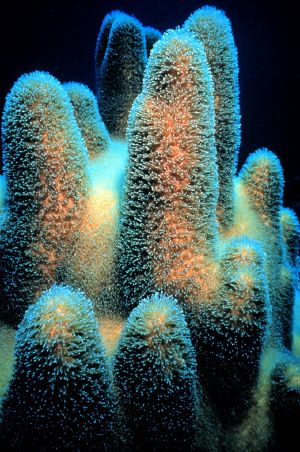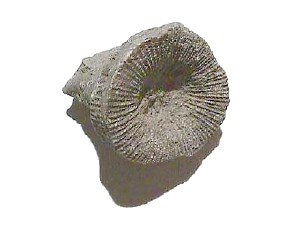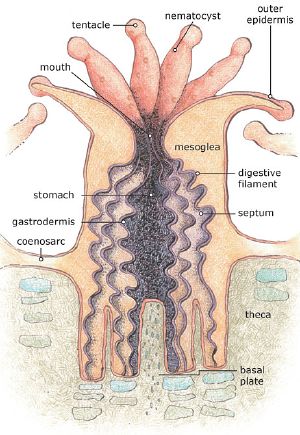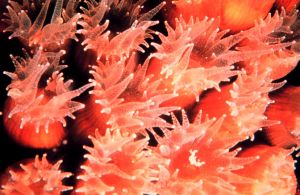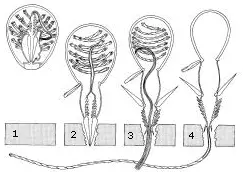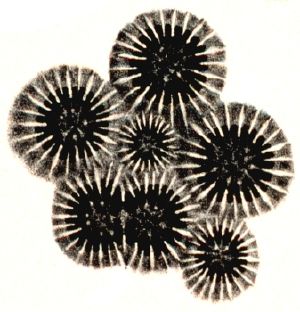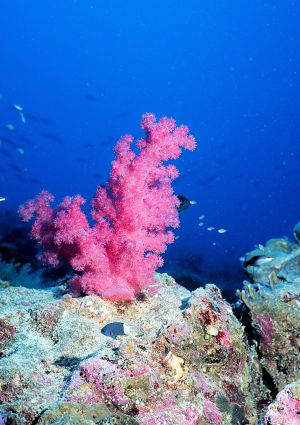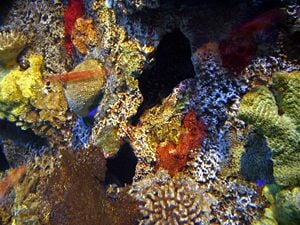Coral
| Corals | ||||||
|---|---|---|---|---|---|---|
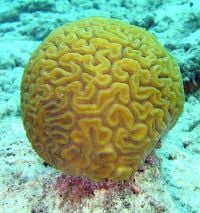 Brain Coral, Diploria labyrinthiformis
| ||||||
| Scientific classification | ||||||
| ||||||
|
Alcyonaria |
Corals (class Anthozoa), which include sea anemones (order Actiniaria), are gastrovascular marine cnidarians (phylum Cnidaria) existing as small sea anemone-like polyps, typically forming colonies of many individuals. The group includes the important reef builders known as hermatypic corals, found in tropical oceans, and belonging to the subclass Zoantharia of order Scleractinia (formerly Madreporaria). The latter are also known as stony corals in as much as the living tissue thinly covers a skeleton composed of calcium carbonate. A coral "head" is formed of many individual polyps, each polyp only a few millimeters in diameter. The colony of polyps function essentially as a single organism by sharing nutrients via a well developed gastrovascular network, and the polyps are clones, each having the same genetic structure. Each polyp generation grows on the skeletal remains of previous generations, forming a structure that has a shape characteristic of the species, but subject to environmental influences.
Although sea anemones can catch fish and other prey items and corals can catch plankton, they obtain much of their nutrient requirement from symbiotic unicellular dinoflagellates (type of algae) called zooxanthellae. Consequently, they are dependent upon growing in sunlight and for that reason usually found not far beneath the surface, although in clear waters corals can grow at depths of 60 m (200 ft). Other corals, notably the cold-water genus Lophelia, do not have associated algae, and can live in much deeper water, with recent finds as deep as 3000 m. Corals breed by spawning, with many corals of the same species in a region releasing gametes simultaneously over a period of one to several nights around a full moon.
Corals are major contributors to the physical structure of coral reefs that develop only in tropical and subtropical waters. Some corals exist in cold waters, such as off the coast of Norway (north to at least 69° 14.24' N) and the Darwin Mounds off western Scotland. The most extensive development of extant coral reef is the Great Barrier Reef off the coast of Queensland, Australia. Indonesia is home to 581 of the world's 793 known coral reef-building coral species.
Phylogeny
The Anthozoa is a class within the phylum Cnidaria and contains the Sea anemones and corals. Corals can be divided into two groups[1]:
The corals are classified into orders as follows:[2][3][4].
- Subclass Alcyonaria (= Octocorallia) (eight tentacles)
- Alcyonacea (soft corals)
- Gorgonacea (sea fans, sea feathers)
- Helioporacea (Indo Pacific blue coral)
- Pennatulacea (sea pens and sea pansies)
- Stolonifera (organ pipe coral)
- Subclass Zoantharia (= Hexacorallia) (more than 8 tentacles - typically 12)
- Antipatharia (black corals, thorny corals)
- Scleractinia (=Madreporaria) (stony corals)
- Corallimorpharia
- Ptychodactiaria
- Extinct orders, from the Paleozoic (570-245 mya)[5].
- Rugosa
- Kilbuchophyllida
- Cothoniida
- Tabulata
- Tabulacondia
- Heliolitida
- Heterocorallida
- Numidiaphyllida
Coral types
There are several other types of corals, notably the octocorals (subclass Octocorallia) and corals classified in other orders of subclass Zoantharia: to wit, the black corals (order Antipatharia) and the soft corals (order Zoanthinaria). Extinct corals include rugose corals and tabulate coral. These two groups went extinct at the end of the Paleozoic. Most other anthozoans would be treated under the common name of "sea anemone".
Geological history
Although corals first appeared in the Cambrian period, some 570 million years ago, they are extremely rare as fossils until the Ordovician period, when Rugose and Tabulate corals became widespread.
Tabulate corals occur in the limestones and calcareous shales of the Ordovician and Silurian periods, and often form low cushions or branching masses alongside Rugose corals. Their numbers began to decline during the middle of the Silurian period and they finally became extinct at the end of the Permian period. The skeletons of Tabulate corals are composed of a form of calcium carbonate known as calcite.
Rugose corals became dominant by the middle of the Silurian period, and became extinct early in the Triassic period. The Rugose corals may be either solitary or colonial, and like the Tabulate corals their skeletons are also composed of calcite. The finest details of their skeletal structures are often well preserved, and such fossils may be cut and polished.
Scleractinian corals diversified during the Mesozoic and Cenozoic eras and are at the height of their development today. Their fossils may be found in small numbers in rocks from the Triassic period, and they are relatively common fossils in rocks from the Jurassic and Cretaceous periods as well as the Caenozoic era. The skeletons of Scleractinian corals are composed of a form of calcium carbonate known as aragonite. Although they are geologically younger than the Tabulate and Rugose corals, the aragonite skeleton Scleractinian corals does not tend to preserve well, so it is often easier to find fossils of the more ancient Tabulate and Rugose corals.
At certain times in the geological past corals were very abundant, just as modern corals are in the warm clear tropical waters of certain parts of the world today. And like modern corals their fossil ancestors built reefs beneath the ancient seas. Some of these reefs now lie as great structures in the midst of sedimentary rocks. Such reefs can be found in the rocks of many parts of the world including those of the Ordovician period of Vermont, the Silurian period of the Michigan Basin and in many parts of Europe, the Devonian period of Canada and the Ardennes in Belgium, and the Cretaceous period of South America and Denmark. Reefs from both the Silurian and Carboniferous periods have been recorded as far north as Siberia, and as far south as Australia.
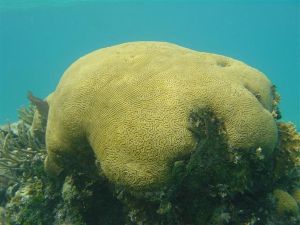
However, these ancient reefs are not composed entirely of corals. Algae and sponges, as well as the fossilized remains of many echinoids, brachiopods, bivalves, gastropods, and trilobites that lived on the reefs help to build them. These fossil reefs are prime locations to look for fossils of many different types, besides the corals themselves.
Corals are not restricted to just reefs, many solitary corals may be found in rocks where reefs are not present (such as Cyclocyathus which occurs in the Cretaceous period Gault clay formation of England).
As well as being important rock builders, some corals are useful as zone (or index) fossils, enabling geologists to date the age the rocks in which they are found, particularly those found in the limestones of the Carboniferous period.
Anatomy
What we see as a coral is a head of many individual, yet genetically identical, polyps. The polyps are multicellular organisms that feed on a variety of small organsims, from microscopic zooplankton to small fish.
Polyps are usually a few millimetres in diameter, and are formed by a layer of outer epithelium and inner jellylike tisue known as the mesoglea. They are radially symmetrical with tentacles surrounding a central mouth, the only opening to the stomach or coelenteron and through which both food is ingested and waste expelled.
The stomach closes at the base of the polyp, where the epithelium produces an exoskeleton called the basal plate or calicle (L. small cup). This is formed by a thickened calciferous ring (annular thickening) with six supporting radial ridges (as shown below). These structures grow vertically so as to project into the base of the polyp allowing it to retreat into the exoskeleton for protection.
The polyp grows by vertical extension of the basal plate forming vertical calices which are occasionally septated to form a new, higher, basal plate. Over many generations this extension forms the large calciferous structures of corals and ultimately coral reefs.
Formation of the calciferous exoskeleton involves deposition of calcium carbonate by the polyps from calcium ions isolated from seawater. The rate of deposition, while varying greatly between species and environmental conditions, can be as much as 10 g / m2 of polyp / day (0.3 ounce / sq yd / day). This is however hugely dependent on light, with production reduced by 90% at night compared to the middle of the day[6].
The tentacles trap prey using stinging cells called nematocysts, these are cells modified to capture and immobilise prey by injecting poisons, firing very rapidly in response to the presence prey. In fire corals these poisons are harmful to humans if a diver touches the coral, however in most cases it is harmless. They can also be found in jellyfish and sea anemones. These cells deliver toxins that immobilise or kill their prey, which can then be drawn into their stomach by the tentacles through a contractile band of epithelium called the pharynx.
Aside from feeding on plankton, corals belong in a symbiotic relationship with a class of algae, zooxanthellae. Typically a polyp will harbour paricular species of algae, which will photosynthesise and thereby provide energy for the coral and aid in calcification[7], while living in a safe environment and using the carbon dioxide and nitrogenous waste produced by the polyp. Due to the strain the algae can put on the polyp, stress on the coral often triggers ejection of the algae, known on a large scale as coral bleaching as it is the algae that gives coral colour. This allows the polyp to live longer during stressful periods, and to regain the algae at a later time; however if the conditions persist the polyps and corals die without the photosynthetic algae[8].
The polyps are interconnected by a complex and well developed system of gastrovascular canals allowing significant sharing of nutrients and symbiotes. In soft corals these have been found to range in size from 50-500 μm in diameter and to allow transport of both metabolites and cellular components[9].
Reproduction
Corals reproduce predominantly sexually, with 25% of hermatypic corals (stony corals) forming single sex (gonochoristic) colonies and the rest hermaphroditic[10]. About 75% of all hermatypic corals release gametes - eggs and sperm - into the water to spread colonies over large distances in what is called broadcast spawning. The gametes fuse during fertilisation to form a microscopic larva called a planula, typically pink and elliptical in shape; a moderately sized coral colony can form several thousands of these per year to overcome the huge hazards that prevent formation of a new colony[11].
Corals that do not broadcast spawn are called brooders, with most non-stony corals displaying this characteristic. These corals release sperm but harbour the eggs, allowing larger, negatively buoyant, planulae to form which are later released ready to settleCite error: Closing </ref> missing for <ref> tag. The larva grows into a coral polyp and eventually becomes a coral head by asexual budding and growth to create new polyps.
Synchronous spawning is very typical on a coral reef, even if there are multiple species on the reef, where all the corals on the particular reef release gametes during the same night. This is essential to coordinate the relase of male and female gametes to allow planula formation. The cues that guide the release are complex but over the short term involve lunar changes and time of sunset, although chemical signalling has not been ruled outCite error: Closing </ref> missing for <ref> tag. In some places the coral spawn can be dramatic, usually occurring at night, where the usually clear water becomes cloudy with gametes.
Within a head of coral the genetically identical polyps reproduce asexually to allow growth of the colony. This is achieved either through gemmation or budding or through division, both shown in the diagrams of Orbicella annularis on the left. Budding involves a new polyp growing from an adult, whereas division forms two polyps as large as the original[11].
Whole colonies can reproduce asexually through fragmentation where a piece broken off a coral head and moved by wave action can continue to grow in a new location.
Environmental effects on coral
Coral can be sensitive to environmental changes, and as a result are generally protected through environmental laws. A coral reef can easily be swamped in algae if there are too many nutrients in the water. They are so sensitive to their environment that, for example, if someone was to cut themselves on a coral cut it would be of a high risk of infection. This is because the coral will plant itself within the wound and act as a sort of parasite, growing in the cut. It will appear as a rash at first and is highly dangerous. Coral will also die if the water temperature changes by more than a degree or two beyond its normal range or if the salinity of the water drops. In an early symptom of environmental stress, corals expel their zooxanthellae; without their symbiotic unicellular algae, coral tissues are colorless, revealing the white of their calcium carbonate skeletons, an event known as 'coral bleaching'[12].
Many governments now prohibit removal of coral from reefs to prevent damage by divers taking pieces of coral. However this does not stop damage done by anchors dropped by dive boats or fishermen. In places where local fishing causes reef damage, such as the island of Rodrigues, education schemes have been run to educate the population about reef protection and ecology.
A combination of temperature changes, pollution, and overuse by divers and jewelry producers has led to the destruction of many coral reefs around the world. This has increased the importance of coral biology as a subject of study. Climatic variations, such as El Niño, can cause the temperature changes that destroy corals.
Some coral species exhibit banding in their skeletons resulting from annual variations in their growth rate. In fossil and modern corals these bands allow geologists to construct year-by-year chronologies, a kind of incremental dating, which combined with geochemical analysis of each band, can provide high-resolution records of paleoclimatic and paleoenvironamental change[13].
Uses
Coral reefs are a great source of tourism for scuba diving or snorkelling, however this has conservational implications due to damage from removal or destruction of coral.
Ancient coral reefs on land are often mined for limestone. An example of this is the quarrying of Portland limestone from the Isle of Portland.
Reddish coral is sometimes used as a gemstone especially in Tibet. Pure red coral is known as 'fire coral' and it is very rare because of the demand for perfect fire coral for jewellery-making purposes.
See also
- Ocean acidification
ReferencesISBN links support NWE through referral fees
- ↑ Fautin, Daphne G. and Romano, Sandra L. (2000). Anthozoa. Sea Anemones, Corals, Sea Pens.. The Tree of Life Web Project. Retrieved 2006-03-31.
- ↑ Chen, C. A., D. M. Odorico, M. ten Lohuis, J. E. N. Veron, and D. J. Miller (June 1995). (pdf) Systematic relationships within the Anthozoa (Cnidaria: Anthozoa) using the 5'-end of the 28S rDNA. Molecular Phylogeny and Evolution 4 (2): 175-183. PubMed.
- ↑ France, S. C., P. E. Rosel, J. E. Agenbroad, L. S. Mullineaux, and T. D. Kocher (March 1996). DNA sequence variation of mitochondrial large-subunit rRNA provides support for a two subclass organization of the Anthozoa (Cnidaria). Molecular Marine Biology and Biotechnology 5 (1): 15-28. PubMed.
- ↑ Myers, P., R. Espinosa, C. S. Parr, T. Jones, G. S. Hammond, and T. A. Dewey (2006). Subclass Alcyonaria. The Animal Diversity Web (online). Retrieved 2006-03-31.
- ↑ Oliver, W. A., Jr. (1996). "Origins and relationships of Paleozoic coral groups and the origin of the Scleractinia", in G. D. J. Stanley (ed.): Paleobiology and Biology of Corals. Columbus, Ohio: The Paleontological Society, 107-134.
- ↑ Anatomy of Coral. Marine Reef. Retrieved 2006-03-31.
- ↑ Madl, P. and Yip, M. (2000). Field Excursion to Milne Bay Province - Papua New Guinea. Retrieved 2006-03-31.
- ↑ W. W. Toller, R. Rowan and N. Knowlton (2001). Repopulation of Zooxanthellae in the Caribbean Corals Montastraea annularis and M. faveolata following Experimental and Disease-Associated Bleaching. The Biological Bulletin 201: 360-373.
- ↑ D. Gateno, A. Israel, Y. Barki and B. Rinkevich (1998). (pdf) Gastrovascular Circulation in an Octocoral: Evidence of Significant Transport of Coral and Symbiont Cells. The Biological Bulletin 194 (2): 178-186.
- ↑ Veron, JEN (2000). Corals of the World. Vol 3, 3rd, Australia: Australian Institute of Marine Sciences and CRR Qld Pty Ltd.. ISBN 0865428344.
- ↑ 11.0 11.1 Barnes, R. and R. Hughes (1999). An Introduction to Marine Ecology, 3rd, Malden, MA: Blackwell Science, Inc., 117-141. ISBN 0865428344.
- ↑ O. Hoegh-Guldberg (1999). (pdf) Climate change, coral bleaching and the future of the world's coral reefs. Marine and Freshwater Research 50 (8): 839-866.
- ↑ D. P. Schrag and B. K. Linsley (2002). Corals, Chemistry, and Climate. Science 296 (8): 277-278. PubMed.
External links
- Coral Reefs of the Tropics: facts, photos and movies from The Nature Conservancy
- Australian Coral Records Research Group
- Coral Identification by Classification and Morphology
- International Council for the Exploration of the Sea: deep-water corals in the northeast Atlantic
- Institute of Marine Research: Coral reefs in Norway
- Reef Corals of the Indo-Malayan Seas: provides an identification key to the black corals, stony corals, soft corals, fire corals and lace corals in the waters of Indonesia and adjacent territories
Credits
New World Encyclopedia writers and editors rewrote and completed the Wikipedia article in accordance with New World Encyclopedia standards. This article abides by terms of the Creative Commons CC-by-sa 3.0 License (CC-by-sa), which may be used and disseminated with proper attribution. Credit is due under the terms of this license that can reference both the New World Encyclopedia contributors and the selfless volunteer contributors of the Wikimedia Foundation. To cite this article click here for a list of acceptable citing formats.The history of earlier contributions by wikipedians is accessible to researchers here:
The history of this article since it was imported to New World Encyclopedia:
Note: Some restrictions may apply to use of individual images which are separately licensed.
